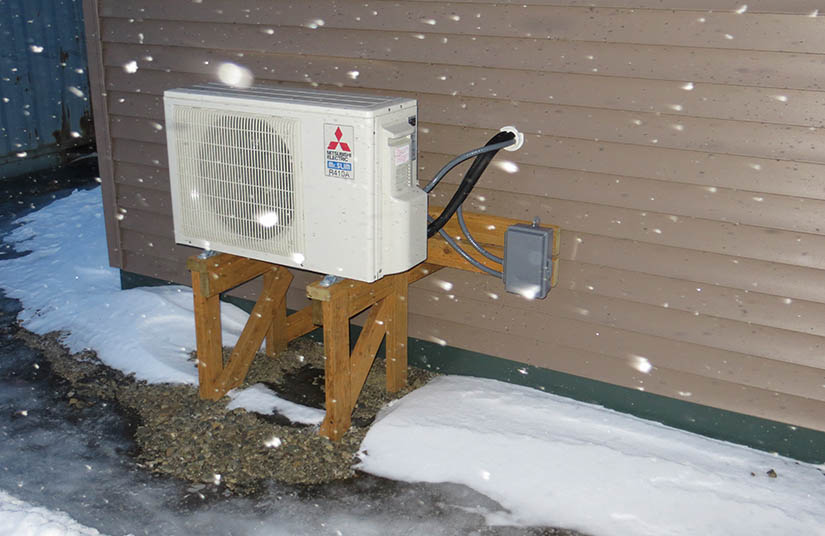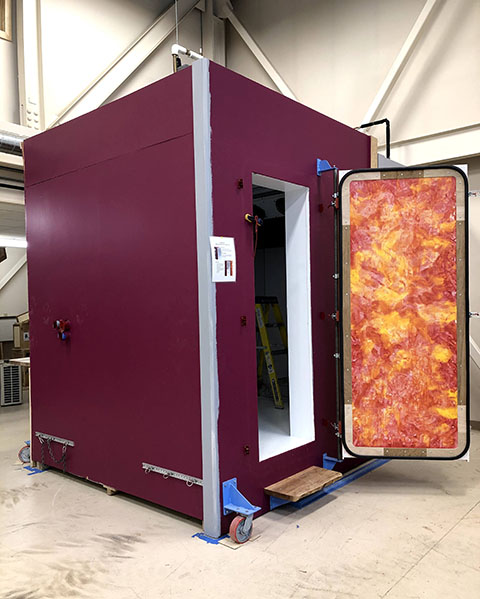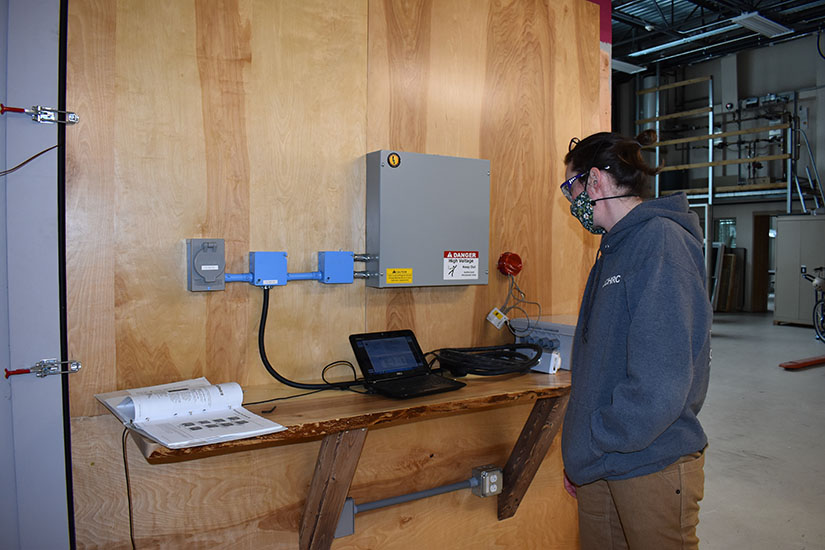Even In Frigid Temperatures In Alaska, Air-Source Heat Pumps Keep Homes Warm
By Molly Rettig
When the north wind blows into Dillingham in the middle of winter, it can plunge well past 15 degrees below zero F on the remote strip of Alaska’s southern coast. On these days, the oil heaters in many of the homes have to run pretty much nonstop to keep people warm.
As you walk through the small fishing town, perched on Bristol Bay’s world-class salmon fishery, you can smell the acrid-sweet scent of wood-burning stoves. But one house stands out from the others: Located on the edge of the town, where spruce forest fades into an endless expanse of frozen, snow-covered tundra, it has no chimney, no fuel tank, no combustion of any kind.
How do you keep a home warm when the temp regularly reach below -15° F?
This is the challenge NREL scientists at the @CCHRC_Alaska are tackling.
See how air-source heat pump could make #energy more affordable, equitable, and environmentally friendly at https://t.co/6L9YoROtxx pic.twitter.com/szYCsZmTVi— NREL (@NREL) March 9, 2021
The air-source heat pump that Tom Marsik installed in his house eight years ago was rare for Alaska. Air-source heat pumps take heat from the outside air, run it through a refrigeration cycle to step up the temperature (just like your fridge, but in reverse), and deliver it to a building. Because they rely on “heat” from the outside air, they were not very common in subarctic climates. Yet, for five years, Marsik’s heat pump kept his family warm even on the chilliest days of the year. Thanks to what researchers have learned from systems like this one, heat pumps are taking off in Alaska and other cold places as an alternative to more traditional heating systems like oil and natural gas.
“It’s exciting because they are operating at lower temperatures than they historically have, which means they have the potential to reduce the consumption of fossil fuels in cold climates,” Marsik said. “Helping to push the boundaries of clean energy and develop a sustainable future was important to me, especially in my own house, where we were raising our daughter.”

Today, Marsik lives in Fairbanks and is chief scientist at the National Renewable Energy Laboratory’s (NREL’s) Cold Climate Housing Research Center (CCHRC). Though he does not live in an air-source-heat-pump-heated home anymore, he still spends a lot of time thinking about them, calculating runtimes and defrost cycles, remembering how he would come running downstairs when he would hear a new noise from his own unit, and researching how to make heat pumps work better for more Alaskans, who face a severe climate, lack of infrastructure, and energy bills five times higher than the average American.
Air-source heat pumps are part of a portfolio of solutions that can advance NREL’s mission of making energy more affordable, equitable, and environmentally friendly. Their role, however, varies across the nation’s vast topography of climates, natural resources, and housing types. NREL researchers are looking at how they can help people in cold climates, based on all of those factors and more.
In Alaska, the technology showing the most promise is a ductless heat pump, which includes an outdoor unit that absorbs heat from the air, and an indoor unit on the opposite side of the wall that delivers it to the room. Because there is no distribution system to spread heat throughout the home, ductless systems are well suited for the small, energy-efficient homes often found in Alaska.
“These are getting a lot of buzz largely because of the relatively low installed cost compared to other systems. Because they just blow air to an open space, you don’t have to pay for the cost of a distribution system,” Marsik said.

Of course, there are unique challenges in a place like Alaska. While heat pumps have improved over the past decade, they are still affected by low temperatures: The colder it gets, the harder it is to extract heat, and the less efficient the system is. But just how much does their efficiency drop? To answer this question, Marsik’s team is studying a heat pump inside a 20-below-zero test chamber in their Fairbanks lab. The study will also look at the effect of thermal loading, or the heat demand of the building, on the heat pump’s performance.
“At very cold temperatures, the efficiency is getting relatively low, and at that point it doesn’t typically make sense to use a heat pump anymore,” Marsik said. “And it is often better to use other technologies.”
Understanding the operating limits of heat pumps will shed light on how they can be expanded nationally. There is a much larger market for air-source heat pumps in the Lower 48, where cold-climate residents are also looking for affordable, cleaner ways to heat their homes. One benefit of heat pumps in less extreme climates is that they can provide both heating and cooling, with the simple switch of a valve. NREL researcher Jon Winkler is leading research to see how to get heat pumps into more of these homes.
The subset of housing he focuses on are those with central, forced-air heating—or roughly 35 million U.S. homes. These homes could switch to a heat pump fairly easily because they already have ductwork. The heat pump simply ties into these existing ducts, like a central air conditioner, to provide conditioned air throughout the home. In places with ductwork and high energy costs, heat pumps are especially attractive—like the Pacific Northwest, for example.
“They already have the ductwork, but they’re using electric resistance heaters, which get the lowest possible heating efficiency. Installing a heat pump in these homes makes a lot of sense financially,” Winkler said.
He is currently monitoring a dozen heat pumps in eastern Washington and Montana to gain a refined look at their efficiency. Similar to the Alaska study, Winkler is looking at how the efficiency of a heat pump drops in colder temperatures, and how to appropriately size a heat pump for a home. There is a twist, though: These heat pumps need to be sized to provide both the right amount of heat and air conditioning.
“So, for these homes, what is the optimal heat pump size from an energy efficiency perspective, a cost perspective, and also from a comfort perspective?” Winkler said.
Furthermore, how can heat pumps be combined with other appliances to provide the most benefit?
“Do you need to provide 100% of the heat with that heat pump?” Winkler said. “Or is it more cost-effective to provide 90% of heating with the heat pump and use an electrical backup resistance heater for those few days of the year it gets really cold?”

That is what Marsik did in his Dillingham house, and what millions of other homes in cold climates could do, too. With the study’s results to come, Winkler’s project will create performance maps that show how heat pumps work in different regions of the country where consumers may want them.
While a growing market demand is driving NREL’s research on heat pumps, it is not just about saving money for consumers, Winkler said. One critical piece of moving toward a clean energy economy is to electrify heating—moving buildings to the grid for heating and air conditioning rather than relying on appliances like oil boilers or gas furnaces. This allows green electrons—whether they come from wind, solar, geothermal, or something else—to provide thermal comfort as well as power.
“If we want to be purely renewable, we’re going to have to electrify our home heating use,” Winkler said, “and heat pumps are currently the best way to do that.”
Learn more about buildings research at NREL and the Cold Climate Housing Research Center.
Article courtesy of the U.S. Department of Energy, NREL.
Have a tip for CleanTechnica? Want to advertise? Want to suggest a guest for our CleanTech Talk podcast? Contact us here.
Latest CleanTechnica.TV Video

CleanTechnica uses affiliate links. See our policy here.
